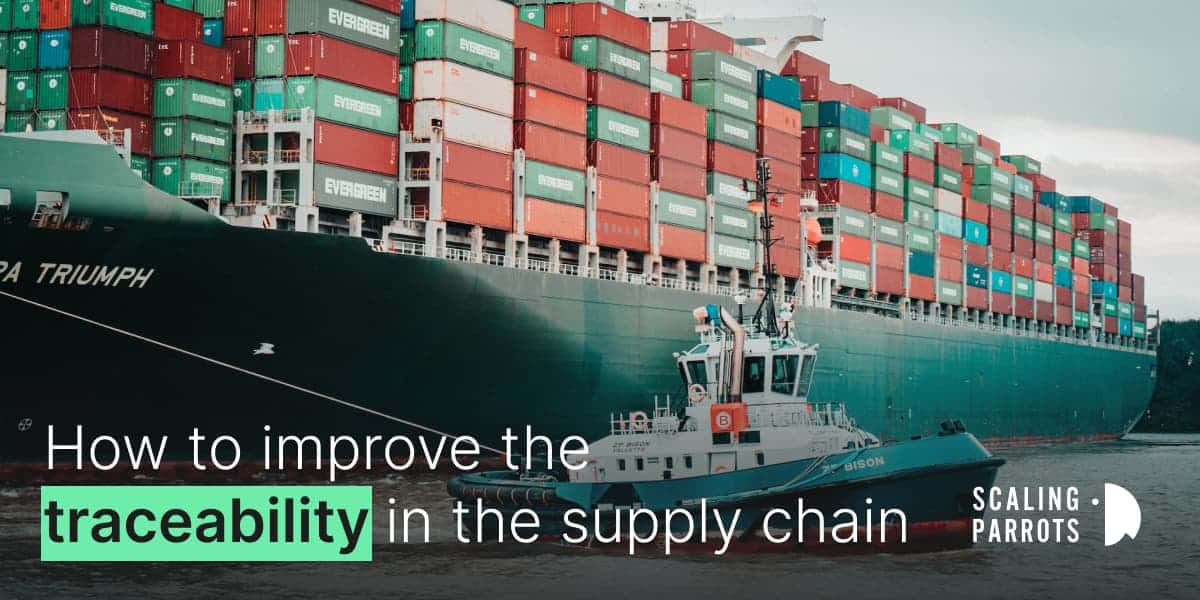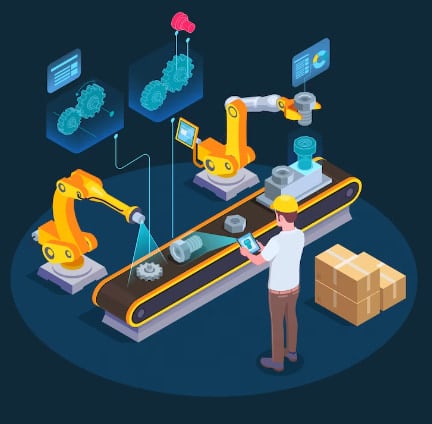
Supply chains are complex systems of manufacturers, suppliers, wholesalers, retailers, and other intermediaries. The supply chain is fragmented and involves many third parties.
Each party has its own database and tracking system that creates inefficiencies, redundant data entry, and inability to track products throughout the entire process. No single company can track a product from raw materials to finished goods.
Due to this, there is an increased demand for solutions that can make supply chains more efficient. That’s where Blockchain comes into play. It’s the perfect solution for fragmented databases and tracking systems because it naturally decentralizes data without sacrificing the security or efficiency of processes.
Read on to learn how Blockchain can strengthen your supply chain by improving traceability and reducing costs with collaborative networks.
What is Blockchain, and how does it work?
A Blockchain is a decentralized and distributed digital ledger that records transactions and assets through a consensus mechanism. It is an incorruptible digital ledger that can be used to record the ownership of assets, track the supply chain, or store data.
It is the underlying technology behind many cryptocurrencies, like Bitcoin. Blockchain is a digital ledger where transactions made in Bitcoin or any other cryptocurrencies are recorded and verified.
These digital ledgers are kept and updated by a network of computers connected to the internet, and a decentralized authority operates this network.
This decentralized network maintains a single, shared, and authoritative version of the transaction data. The data is stored in a series of blocks. The records stored in these blocks can be accessed and verified by anyone in the network.
Why is traceability important in the Supply Chain?
Traceability means being able to follow the journey of a product through the supply chain. When a product arrives in a store, the customers want to know where it’s from, how it’s been made, and who has handled it.
The supply chain is a very important part of a product’s branding, and Blockchain can be used to improve traceability.
- Quality control
Traceability helps manufacturers ensure they’re working with high-quality materials and that they meet the required standards and specifications. If you are producing a clothing item, you might source your fabric from a supplier, and then that supplier might source their fabric from another supplier. If you don’t have a way of tracing the fabric back to its original source, you can’t guarantee that it’s the right type of fabric. You can locate the original source of your fabric in a Blockchain network. If there is a problem, you can identify the root cause and repair it before it affects both you and your customers. This will help you maintain high standards and produce better-quality products.
- Fight against counterfeiting
When you use Blockchain to improve traceability and trace your products, you can also verify their authenticity. When you’re a manufacturer, you have to be able to verify that your products are authentic. Otherwise, there will be knock-off products of your product on the market. This is a problem that many manufacturers face and one that Blockchain can help to solve. With Blockchain, you can verify that your products are authentic and have been created through the public ledger. This will help you to fight against counterfeiting.
- Operational efficiency
A blockchain network can be used to standardize how your company operates. It can be used to track orders being purchased and business contracts. You can also use Blockchain to track your assets. At the moment, you’re probably using Excel spreadsheets to manage all of this information. These are inefficient and consume a lot of time and money. Using Blockchain for these processes will provide you with real-time visibility, traceability, and auditability.
- Customer satisfaction
You can create better customer experiences with better traceability and visibility. If your customers have a problem, you can use Blockchain to track the issue and fix it quickly. When something goes wrong in the supply chain, it can be challenging to know the source of the problem. With Blockchain, you can quickly track the issue and solve it. This will provide your customers with better experiences and create more satisfied customers.
How does Blockchain improve traceability?
In today’s global economy, supply chains are long and complex. Products often change hands multiple times before they reach the consumer, making it difficult to track their origins.
This can pose a problem when trying to ensure that products are safe and high-quality. Blockchain technology can help to improve traceability in several ways.
- First, Blockchain can be used to create a tamper-proof record of data that can be used to track the movement of assets through a supply chain. This means that it will be immediately apparent if there is any attempt to tamper with the data.
- Second, Blockchain can be used to create smart contracts that automate tracking assets and verifying compliance with regulations. This can help to speed up the process of tracing assets and ensure that all relevant parties have access to the correct information.
- Finally, Blockchain can be used to create a decentralized marketplace for tracking assets, which can make it easier for buyers and sellers to find each other and trade assets transparently and efficiently.
How does Blockchain improve the Supply Chain?
A Blockchain is a distributed ledger that records transactions and other data related to a product’s handling and ownership.
It is useful in traceability systems because it allows data to be recorded at each stage of the supply chain and then shared among all participants, providing transparency into all steps a product has gone through.
- Efficiency
The Blockchain network can be programmed only to allow authenticated computers to add new data and access the data in the system. In the case of traceability, this limits the data to only those computers that take part in the supply chain.
This means that only the farmer who harvests the product, the supplier who buys it from the farmer, the wholesaler who buys from the supplier, and the retailer who buys from the wholesaler, can input information about each stage of the supply chain. This means that the entire supply chain must be computerized, which is not the case for most supply chains.
Moreover, Blockchain’s decentralized approach, where each computer in the Blockchain network keeps a copy of the ledger, makes it resilient to attacks or data loss in individual computers. This can ensure that the supply chain does not break down during heavy data traffic or high-volume data access.
- Transparency
Blockchain’s transparency is an advantage of the technology. Once the data is entered, it cannot be modified or deleted. This means that the information is always there and cannot be altered.
If a food company has to provide proof of compliance with a quality standard or food safety regulation (such as the ones in the United States that require Country of Origin Labeling or Organic labeling), it can use Blockchain to prove that it met the standard. With Blockchain, a company can create an immutable record of compliance that can be shared publicly to build trust with consumers and regulators.

Benefits of Blockchain technology in Supply Chain traceability
In addition to the general advantages of Blockchain technology described above, Blockchain has some further advantages in supply chain traceability. They include:
- Accuracy
In a Blockchain network, each computer has a duplicate of the ledger; any data entry error is identified immediately and automatically corrected. This means that the data is always consistent and accurate, reducing the risk of mislabeled or misidentified products or faulty traceability information.
This accuracy also extends to data about the state of the product, such as temperature and place. This information can be written onto the Blockchain and shared among participants to create certainty about the product’s condition at all supply chain stages. For example, chickens slaughtered at a farm can be tracked all the way to the supermarket and monitored for the right refrigeration temperature.
- Efficiency
As the Blockchain network is decentralized, and the data is distributed among all computers in the network, data access and readability are not dependent on a central computer. In the case of a traceability system, the Blockchain is programmed to add new data only when all computers agree on the state of the data.
This avoids the “race to write” problem in centralized systems, in which there is a risk that one computer will write a data entry before another computer has finished reading that data. This delays or breaks down the data flow in the system, which is a frequent problem in supply chain traceability systems. This efficiency also applies to the time needed for data entry.
In centralized systems, auditors must access all computers to verify the data in the system. In decentralized Blockchain systems, auditors can access all data in the Blockchain, including their history, without going through central computers. This speeds up the auditing process.
- Security
All computers in a Blockchain network have a duplicate of the ledger, so it is nearly impossible for one computer to tamper with the data in the system. If one computer attempts to change the data, all other computers will identify the change and reject it, ensuring that the data is not corrupted.
This makes Blockchain more secure than centralized systems, where data is stored in one place and can be tampered with if a computer is hacked or compromised. Whereas a centralized database can be retroactively corrupted or altered, Blockchain’s decentralized nature makes it impossible to alter it retroactively.
This means that any tampering with the data at one stage of the supply chain will be detected at another stage.
- Transparency and traceability
Blockchain is transparent; it allows companies to prove that they met a standard, such as Organic certification or compliance with food safety regulations. This can help to build consumer trust as to the provenance of the product and its quality.
In addition, Blockchain allows information to be securely and immutably shared among all participants in the supply chain. This allows them to trace a product back to its source, which is important to swiftly detect and contain contamination in the event of an outbreak.
- Consumer confidence
Blockchain allows data to be shared among all participants in the supply chain; consumers can trace a product back to its source and understand exactly how it was handled and where it came from.
This builds consumer confidence as they can trace the product to where it was grown or harvested. This traceability information can be verified by the consumer and validated by third parties, such as governmental agencies or non-profit organizations that are part of the supply chain.
As the Blockchain ledger is distributed among all participants in the supply chain, it can be used as a decentralized food traceability system that does not rely on a centralized database. While Blockchain can contribute to food safety in various ways, it is worth noting that it cannot solve all food safety problems. As with any type of technology, there are limitations to its usefulness.
Moreover, many companies that are considering Blockchain may face challenges in implementing it, as the technology is in a state of rapid change.
Real uses and examples of Blockchain traceability in Supply Chain
- Provide Diamond Supply Chain Transparency: Brilliant Earth
Blockchain technology is being used in the diamond industry to provide transparency throughout the supply chain, from mine to market. This is important because diamonds are often associated with conflict and human rights abuses.
Brilliant Earth is a diamond retailer using Blockchain technology to trace the origin of its diamonds. The company has partnered with Everledger, a startup that uses Blockchain to track and verify the provenance of luxury assets.
Everledger’s Blockchain platform enables Brilliant Earth to track each diamond from its point of origin through the supply chain. This information is stored in an immutable digital ledger, providing a transparent record of a diamond’s journey.
This traceability helps ensure that Brilliant Earth’s diamonds are conflict-free and sourced from ethical mines. It also offers customers peace of mind knowing that their diamond has been ethically sourced.

- Boost Drug Safety: Merck and Walmart
Merck, the global pharmaceutical giant, and Walmart, the world’s largest retailer, have partnered to use Blockchain technology to help boost drug safety. The two companies will pilot a new Blockchain-based system that will track prescription drugs from manufacture to sale. The aim is to help ensure that patients receive safe and effective medications.
The new system will create a digital ledger of information on each drug’s journey through the supply chain. This will include data on where and when the drug was made, who shipped it, and where it was sold. The information will be available to all parties in the supply chain, including patients and regulators.
The partnership is part of a wider effort by Merck to use Blockchain technology to improve the safety of its products. The company has also piloted a system for tracking clinical trial data and is exploring using Blockchain to track other medical products.
The partnership between Merck and Walmart is an important step forward for using Blockchain in supply chains. By working together, these two companies can help set standards for others to follow. This could lead to improved safety for patients around the world.
- Ensure Saleable Drug Returns: FFF Enterprises
To ensure that drug returns are saleable, FFF Enterprises employs Blockchain traceability in its supply chain. By tracking the provenance of drugs throughout the supply chain, FFF Enterprises can ensure that returned drugs have not been tampered with and are still fit for sale. This allows FFF Enterprises to offer its customers a higher level of assurance that they are receiving safe and effective drugs.
- Provide tracking info to consumers: Bumble Bee Seafoods
Bumble Bee Seafoods is one of the first companies to use Blockchain technology to track their seafood products from “catch to counter.” By working with IBM, they developed a system that allows consumers to track the journey of their seafood using the Blockchain. When caught, each fish is given a unique ID, and that ID is added to the Blockchain.
As the fish moves through the supply chain (to the processing plant, distribution center, and finally to the grocery store), each step is recorded on the Blockchain. This way, consumers can trace their seafood back to its source, ensuring that it’s fresh and sustainable.
This system provides transparency for both Bumble Bee Seafoods and consumers. Consumers can be confident that they’re getting fresh seafood that is sustainably sourced. And Bumble Bee Seafoods can build trust with consumers by being open about where their seafood comes from and how it’s processed.
Conclusion
The Blockchain technology is a decentralized and distributed digital ledger that records transactions and assets through a consensus mechanism. It is an incorruptible digital ledger that can be used to record the ownership of assets, track the supply chain, or store data.
This is a perfect solution for fragmented databases and tracking systems because it naturally decentralizes data without sacrificing the security or efficiency of processes. When you use Blockchain to improve traceability, you store the data in a single shared ledger. This allows you to access this information and use the data to track your products through the supply chain.
See you soon,
Scaling Parrots
